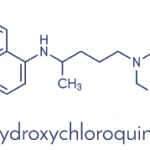Introduction & Objectives
Both hydroxychloroquine (HCQ) and chloroquine (CQ) are used for the treatment of specific rheumatic and dermatologic diseases. HCQ and CQ were initially developed for treating malaria and have been used since 1955 and 1935, respectively. The most frequent rheumatic diseases for which these medications are used include systemic lupus erythematosus (SLE) and rheumatoid arthritis (RA). They are also used to treat discoid and subacute cutaneous lupus erythematosus, as well as dermatomyositis and other autoimmune skin conditions. Based on actual body weight, recommended HCQ and CQ dosing in rheumatic disease patients is ≤5 mg/kg/day and ≤2.3 mg/kg/day, respectively. Higher doses are associated with increased retinal toxicity.
Although arrhythmias and conduction system abnormalities, as well as cardiomyopathy, have been rarely reported in association with HCQ/CQ use, this white paper reviewed and summarized the current understanding of HCQ/CQ cardiac toxicity, describing factors that may increase the risk of HCQ/CQ-associated QTc prolongation.
What the Studies Say
Recent studies, as well as earlier case reports, have shown QTc prolongation with HCQ or CQ at conventional doses used to treat rheumatic disease.
In a Veterans Administration study of more than 800 patients with rheumatic disease (90% male and 10% female) who were taking HCQ and had available electrocardiogram (EKG) data, HCQ was associated with QTc prolongation in 8.5% (7% with QTc 470–500 ms and 1.5% with QTc >500 ms) (37). Among 591 patients in this study who had paired EKG data before and after starting HCQ, 23 patients (3.9%) had either a >15% increase in QTc or a QTc of >500 ms with HCQ treatment. Chronic kidney disease, atrial fibrillation history, and heart failure were independent risk factors for QTc prolongation with HCQ use in the study. While QTc >470 ms with HCQ therapy was associated with long-term mortality in a univariate Cox regression analysis, this increased mortality risk was no longer apparent after adjustment for age, sex, and comorbidities. In patients with paired EKG data, change in QTc was not associated with mortality (hazard ratio 1.001 [95% confidence interval (95% CI) 0.998–1.005], P=0.51).
Both HCQ and CQ accumulate in mammalian lysosomes and cause a more alkaline pH. HCQ and CQ concentrate in the eyes (particularly in the melanin-containing retinal pigment epithelium), adrenal and pituitary glands, kidney, bone marrow, lung, liver and cardiac tissue. This accumulation of drug in lysosomes may confer efficacy in the treatment of rheumatic and cutaneous conditions, but also may be responsible for toxicities, such as atrioventricular (AV) conduction defects and myocardial deposition disease. Although channel blockade tends to be dose dependent and more immediate, cardiac toxicities related to HCQ/CQ deposition require a longer duration of treatment.
Accumulation of HCQ/CQ in lysosomes of cardiac myocytes may lead to arrhythmias and infiltrative cardiomyopathy.
It should be recognized that RA and SLE are themselves established independent risk factors for atherosclerotic CVD, especially with high disease activity. RA patients are more likely to be hospitalized for acute myocardial infarction (MI) or to have an unrecognized MI, and disease duration of more than 10 years confers higher MI risk. Among patients with SLE, the relative risks of nonfatal MI and of death due to cardiovascular disease (CVD) have been estimated to be 10.1 (95% CI 5.8–15.6) and 17.0, respectively. Traditional risk factors further increase CVD risk in individuals with RA or SLE.
In observational studies, HCQ use has been associated with lower CVD risk in RA and SLE populations. In RA, a retrospective study showed a 72% lower CVD risk among HCQ-treated compared to non-HCQ-treated patients.
Key Points
HCQ and CQ are important medications used in SLE and RA with known clinical benefits, and patients should not stop taking them without talking to their prescriber. The risk of cardiac toxicity is considered to be low in comparison to the benefits of these medications. There is risk of torsade de pointes with the use of HCQ/CQ that is thought to be low. Current data do not support institution of specific recommendations regarding how to avoid these adverse effects; options include establishing a baseline EKG in patients with multiple risk factors and follow-up EKGs in patients with prolonged QTc or those receiving HCQ/CQ in combination with other QTc-prolonging therapies. Cardiomyopathy and conduction blocks are reported with long-term use of these agents, and providers should be vigilant to screen for cardiac symptoms in their patients.
Refer to the full article for all source material.
Excerpted and adapted from:
Desmarais J, Rosenbaum JT, Costenbader KH, et al. American College of Rheumatology white paper on antimalarial cardiac toxicity. Arthritis Rheumatol. 2021 Dec;73(12).

